Stomata are tiny pores found on the leaves and stems of plants, which are responsible for gas exchange and transpiration. In the previous post we discussed the Structure and Functions of Stomata. However, did you know that not all stomata are created equal? In this article, we will discuss the classification of stomata and explore the different types that exist in the plant kingdom.
Classification of Stomata
Classification of stomata based on the number and arrangement of subsidiary cells.
Ø Proposed by Metcalfe and Chalk (1950)
Ø Four types of stomata:
- Anomocytic Stomata
- Anisocytic Stomata
- Diacytic Stomata
- Paracytic Stomata
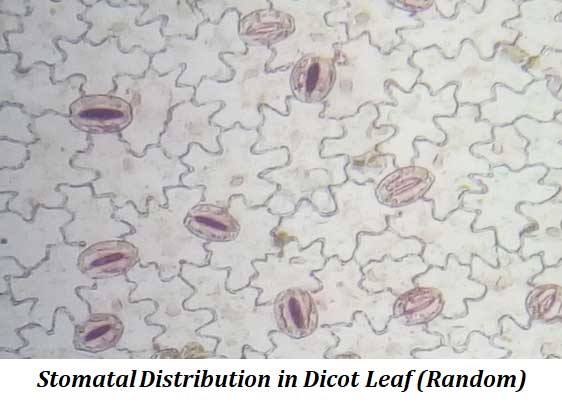
Anonocytic Stomata
Ø Also called Rananculaceous type.
Ø These stomata lack any specialized subsidiary cells and are characterized by a random distribution of surrounding epidermal cells.
Ø Here the subsidiary cells are indistinguishable from other epidermal cells.
Ø Anomocytic stomata are found in members of Ranunculaceae, Papaveraceae, Malvaceae
Ø Considered as most primitive type of stomata.
Anisocytic stomata
Ø Also called Cruciferous type.
Ø Characterized by the presence of three subsidiary cells.
Ø Among these three cells, one is smaller and the other two are relatively larger.
Ø Found in members of Cruciferae, Solanaceae, Convolvulaceae, Nicotiana
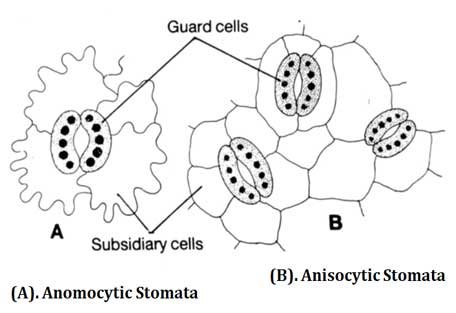
Diacytic Stomata
Ø Also called Caryophyllaceous type.
Ø Here the stomata remain enclosed by a pair of subsidiary cells whose common wall is at right angles to the long axis of the guard cells.
Ø Found in members Caryophyllaceael, Lamiaceae, Acanthaceae
Paracytic stomata
Ø Also called Rubiaceaous type.
Ø Here the stomata are accompanied on either side by one or more subsidiary cells which lie parallel to the long axis of the pore and guard cells.
Ø Found in members of Rubiaceae
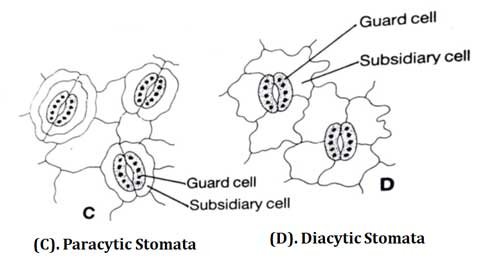
Stace in 1965 included two more categories of stomata – Actinocytic stomata and Cyclocytic stomata
Actinocytic stomata
Ø Also called radiate stomata.
Ø Characterized by the radial arrangement of subsidiary cells around the stomatal pore.
Ø The cells surrounding the pore are typically arranged in a star-like pattern, with each cell extending from the pore to form a spoke-like structure.
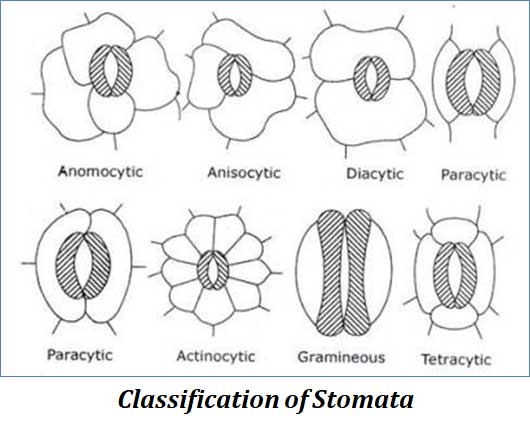
Cyclocytic Stomata
Ø Here four or more subsidiary cells arranged as closed rings around the stomata.
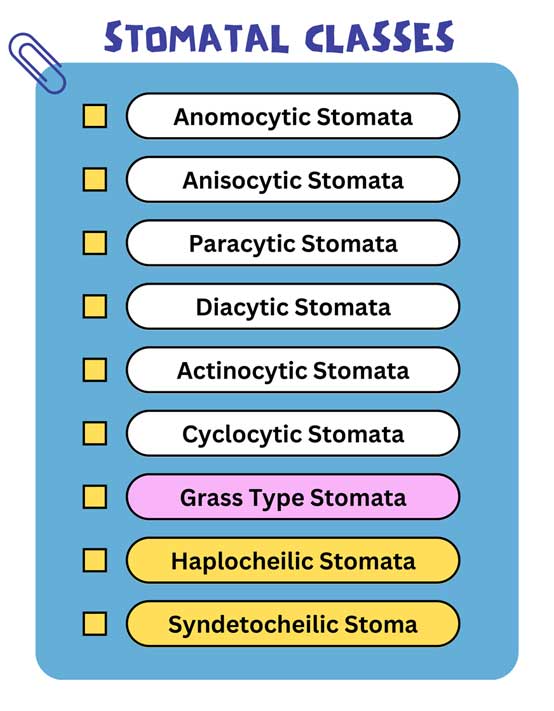
Classification of stomata based on ontogeny (development)
Ø Florin in 1959 recognized two types of stomata based on ontogeny.
Ø They are
- Haplocheilic stomata
- Syndetocheilic stomata
Haplocheilic stomata
Ø Guard cells and subsidiary cells of stomata originate from two separate cells.
Ø Two guard cells of a stomata arise from the single division of the stomatal initial.
Ø The neighbouring cells become modified into subsidiary cells.
Syndetocheilic stomata
Ø The guard cells and subsidiary cells of the stomata arise from the same stomatal initial.
Learn more: Difference between Syndetocheilic and Haplocheilic Stomata
Pant in 1965 recognized three types of stomata based on development
Ø Mesogenous type: Both guard and subsidiary cells are derived by consecutive division of same mother cell as found in members of Rubiaceae and Cruciferae.
Ø Mesoperigenous type: In this case, surrounding cells are dual in origin, i.e. some from the mother cell and some from the neighbouring cell, as found in members of Ranunculaceae and Caryophyllaceae.
Ø Perigenous type: In this type, all neighbouring and subsidiary cells have independent origin, as found among members of Cucurbitaceae and Nymphaeaceae.
| You may also like NOTES in... | ||
|---|---|---|
| BOTANY | BIOCHEMISTRY | MOL. BIOLOGY |
| ZOOLOGY | MICROBIOLOGY | BIOSTATISTICS |
| ECOLOGY | IMMUNOLOGY | BIOTECHNOLOGY |
| GENETICS | EMBRYOLOGY | PHYSIOLOGY |
| EVOLUTION | BIOPHYSICS | BIOINFORMATICS |
Classification of Leaves based on Distribution of Stomata
Ø Leaves can be classified based on the distribution of stomata on their surface.
Ø Different types of leaves have different stomatal arrangements.
Ø Difference in the arrangement of stomata is the adaptation to specific environmental conditions.
Ø There are Five types of leaves based on the distribution of stomata:
- Hypostomatic Leave
- Epistomatic Leaves
- Amphistomatic Leaves
- Isostomatic Leaves
- Astomatic Leaves
Hypostomatic leaves
Ø Hypostomatic leaves have stomata on the lower surface only.
Ø The most common type of stomatal distribution in leaves.
Ø It is well-suited for plants growing in hot and dry environments.
Ø Having stomata on the lower surface helps reduce water loss by minimizing exposure to the sun and wind.
Ø Example: apple, peach, mulberry, walnut etc.
Epistomatic leaves
Ø Epistomatic leaves have stomata on the upper surface only.
Ø This type of stomatal distribution is rare, and is typically found in floating aquatic plants.
Ø Stomata on the upper surface allow efficient gas exchange in a water-rich environment.
Amphistomatic leaves
Ø Amphistomatic leaves have stomata on both the upper and lower surfaces.
Ø Number of stomata will be more on the lower side of the leaf than the upper side.
Ø This type is common in plants that grow in temperate or humid environments.
Ø The distribution of stomata on both surfaces allows for efficient gas exchange, but also increases the risk of water loss, making it less suitable for plants growing in arid environments.
Ø Example: Potato, Cabbage, Tomato
Isostomatic leaves
Ø Stomata are equally distributed on the both lower and upper surface of the leaves.
Ø Example: Oats
Astomatic leaves
Ø Stomata are altogether absent or if present, they will be vestigial and non-functional.
Ø Such type of leaves is often found in submerged aquatic plants where stomata is not required.
Ø Example: Potamogeton, Hydrilla
Ø Stomata may occupy three different positions with regards to the epidermal cells.
Ø Stomata found at the same level as in most mesophytes.
Ø Stomata are sunken, found in depression as in xerophytes.
Ø Stomata are slightly raised above the surface of epidermis as in Cucurbita.
<<< Back to Plant Anatomy Notes
| You may also like... | ||
|---|---|---|
| NOTES | QUESTION BANK | COMPETITIVE EXAMS. |
| PPTs | UNIVERSITY EXAMS | DIFFERENCE BETWEEN.. |
| MCQs | PLUS ONE BIOLOGY | NEWS & JOBS |
| MOCK TESTS | PLUS TWO BIOLOGY | PRACTICAL |
Dear readers
I believe that this article helped you to understand the Classification of Stomata. I would like to take this opportunity to request your COMMENTS on this topic. Whether you have a suggestion, a question about the topic, or simply want to share your thoughts, I would love to hear from you. So, please don’t hesitate to leave a comment below. I appreciate your support and look forward to hearing from you.
Best regards, [Admin, EasyBiologyClass]
